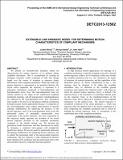Extensible-Link Kinematic Model for Determining Motion Characteristics of Compliant Mechanisms
Author(s)
Beroz, Justin Douglas; Awtar, Shorya; Hart, Anastasios John
Downloadv06at07a029-detc2013-12582.pdf (976.1Kb)
PUBLISHER_POLICY
Publisher Policy
Article is made available in accordance with the publisher's policy and may be subject to US copyright law. Please refer to the publisher's site for terms of use.
Terms of use
Metadata
Show full item recordAbstract
We present an extensible-link kinematic model for characterizing the motion trajectory of an arbitrary planar compliant mechanism. This is accomplished by creating an analogous kinematic model consisting of links that change length over the course of actuation to represent elastic deformation of the compliant mechanism. Within the model, the motion trajectory is represented as an analytical function. By Taylor series expansion, the trajectory is expressed in a parametric formulation composed of load-independent and load-dependent terms. Here, the load-independent terms are entirely defined by the shape of the undeformed compliant mechanism topology, and all load-geometry interdependencies are captured by the load-dependent terms. This formulation adds insight to the process for designing compliant mechanisms for high accuracy motion applications because: (1) inspection of the load-independent terms enables determination of specific topology modifications for improving the accuracy of the motion trajectory; and (2) the load-dependent terms reveal the polynomial orders of principally uncorrectable error components of the motion trajectory. The error components in the trajectory simply represent the deviation of the actual motion trajectory provided by the compliant mechanism compared to the ideally desired one. We develop the generalized model framework, and then demonstrate its utility by designing a compliant micro-gripper with straight-line parallel jaw motion. We use the model to analytically determine all topology modifications for optimizing the jaw trajectory, and to predict the polynomial order of the uncorrectable trajectory components. The jaw trajectory is then optimized by iterative finite elements (FE) simulation until the polynomial order of the uncorrectable trajectory component becomes apparent.
Date issued
2013-08Department
Massachusetts Institute of Technology. Department of Mechanical Engineering; Massachusetts Institute of Technology. Department of PhysicsJournal
Volume 6A: 37th Mechanisms and Robotics Conference
Publisher
ASME International
Citation
Beroz, Justin, Shorya Awtar, and A. John Hart. “Extensible-Link Kinematic Model for Determining Motion Characteristics of Compliant Mechanisms.” Volume 6A: 37th Mechanisms and Robotics Conference (August 4, 2013).
Version: Final published version
ISBN
978-0-7918-5593-5